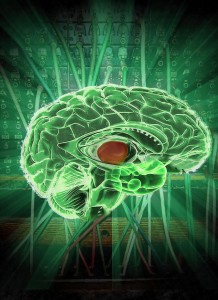
This is an image of a human brain. The thalamic reticular nucleus (TRN) surrounds the thalamus (pictured in red, with a switchboard in the background). view more
Credit: Michael Halassa.
Researchers at NYU Langone Medical Center say they have added to evidence that a shell-shaped region in the center of the mammalian brain, known as the thalamic reticular nucleus or TRN, is likely responsible for the ability to routinely and seamlessly multitask.
The process, they suggest, is done by individual TRN neurons that act like a “switchboard,” continuously filtering sensory information and shifting more or less attention onto one sense — like sight — while relatively blocking out distracting information from other senses, including sound.
In their research in mice, described in the journal Nature online Oct. 21, the investigators showed that TRN neurons, which have been previously implicated in the dampening of brain signals […]










